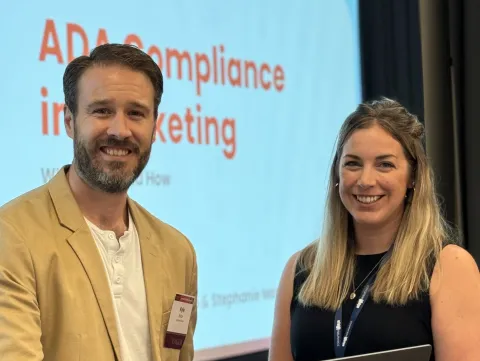We brought our accessible design expertise to the Sunshine State
Did you hear about the man who sued Domino’s Pizza when he wasn’t able to order online due to his vision impairment? As much as that sounds like a lead-up to a terrible punchline, it really happened. The point is, ADA compliance in marketing (ADA stands for Americans with Disabilities Act) is a big deal, and it’s been gaining traction in the minds of business leaders.
As an agency that puts a whole lot of time and effort into ADA compliance and accessible design, we were honored to be called on by the Insurance Marketing Communications Association (IMCA) to share our ADA expertise at their annual marketing conference in Orlando, Florida. Accompanied by CEO Edward Estipona, our accessibility champions — Kyle Brice (VP of Strategy) and Stephanie Mazza (Senior Art Director) — led two breakout sessions titled “ADA Compliance in Marketing: What, Why and How.” After their jet lag wore off, we picked their brains about the strategic and creative side of ADA compliance in marketing.
Of all the agencies, why were we invited?
Kyle
We’ve made ADA compliance a priority. It's harder to make a website that’s ADA compliant than one that isn't. It's harder to make a PDF ADA compliant than one that isn't. Where some groups might shy away from that, we lean into it, and in doing so, we create better content overall. We work it into our day-to-day process, which has allowed us to have expertise in the broad scope of implementing it into comprehensive marketing plans.
Edward
There aren't a lot of agencies that have prioritized ADA the way we have. This is something we’ve spent a lot of time on, including our development partners who are hell-bent on this space. Since 2018, we’ve worked to bring ADA to the forefront by sharing our expertise and free resources — like our Web Content Accessibility Guidelines and ADA Principles Guide. Because of how we’ve emphasized ADA compliance within our agency, we’ve become industry leaders in this space and we’re more searchable than other agencies who haven’t made it a priority.

What makes you an Accessibility expert?
Stephanie
My expertise in accessible design includes hands-on design, such as web design, printed collateral design and PDF remediation. With ADA compliance being such an important element of our work at EG, I have become the “accessibility champion” in my role leading the design department. I actively dig into research and changes in accessibility best practices, working with our social, digital and client-facing teams to educate internally and with our partners.
Kyle
I have been discussing ADA compliance in websites since I started working in the industry more than a decade ago. Over the years, technology has changed and the idea of what makes a website accessible has grown and changed. I’ve had to keep up with those changes in best practices and maintain a sense of what continues to be the standard. I regularly work with designers and developers and continually change processes to meet new standards as they develop. Each client is also going to be held to a different standard based on their industry and the clientele they serve, so understanding those differences has been a very important element of my job.
Why was this an exciting opportunity?
Edward
This is something we’ve been actively working on since 2018 because, realistically, all public-facing sites should be ADA compliant. From a risk mitigation standpoint, those who attended the conference know that at some point, some of the businesses they’re covering could get sued for having a non-compliant site. So I think they’ll bring the information back to their teams, and that could impact the businesses they cover in terms of bringing ADA compliance to the forefront and promoting it as a standard practice for more companies.
Stephanie
I love the opportunity to talk with people in other industries to learn about how their business works. It's interesting to me as a creative person because we're always working with people who are experts in their field, but not necessarily experts in creativity — it's a great give-and-take collaboration.
It was also extremely rewarding to talk about accessible design with people who know enough about it to know that it's important, but not necessarily where to start. The questions we received at the end of our talk were very thoughtful and some more sophisticated than what we were expecting. It was great to hear about companies that were already in the process of creating an accessible website but needed help communicating with their developers or management.
What is the importance of ADA compliance in marketing?
Kyle
The more people that have access to your website and content, the better you’re serving your clientele. Roughly 25% of Americans have some level of disability, not including people who are temporarily or situationally disabled. So by taking accessibility into account, not only are you providing a better user experience, but you’re broadening your customer base.
Edward
Unfortunately, people don’t think about accessibility problems until they’ve experienced it themselves. From an ethical standpoint, ADA compliance is the right thing to do because it’s about ensuring equitable access to the right information.
It also makes sense financially — there’s an opportunity loss for those who choose not to make their site accessible. For example, the prime client for an insurance marketer is people 60+ years old due to their high net wealth. But what if that client couldn’t access the insurer’s information because they can’t see or hear well? Choosing not to spend the money up front to make the site ADA compliant could mean losing that client to a different insurer that provides a more accessible experience.

What did you gain from the experience?
Stephanie
Giving this talk was a great opportunity because it got me digging more into aspects of accessible design that I don't normally touch, such as the backend of web development and legal considerations. Presenting with Kyle was great because I am able to fully explain the design and compliance issues, where he dove into the strategy and collaboration with executive teams.
At Estipona Group we already understand accessible design deeply but when you're giving a talk to a new audience it opens up new questions to dig into such as regulations in that industry and roadblocks they might face being in large corporate environments. I also learned a lot about insurance marketing, what goes into it and what it's like working in-house in a company that’s in charge of upwards of 70 sub brands.
Kyle
It was a learning experience. Stephanie and I found ourselves researching topics we’ve never needed to dig into, like ADA compliance in employee-facing platforms. A lot of the definitions created for accessibility were built around physical businesses, so any physical or digital place of business that is publicly accessible has to be ADA compliant. But what happens when you have a private business that isn’t open to the general public? The same question applies to websites that aren’t inherently public-facing, like an internal log-in platform for employees.
While there are certain employment standards that ensure accessibility, ADA compliance is not so black and white in these spaces. My takeaway is that while some might argue there’s some insulation here, making your public-facing site ADA compliant and then ignoring any of your gated or internal sites feels like a misstep and creates an area for potential risk to your company and your employees.
What is our commitment concerning ADA compliance?
Edward
We’re committed to researching, learning, evolving and working closely with our development team to provide more access and a better user experience throughout our work. While I predict that someday, Google will put ADA mandates in place, this likely won’t happen until there’s a more elegant and cost-effective solution that doesn’t create monetary bias against small businesses. In the meantime, we’ll continue to preach it, push it and practice it because it’s the right thing to do.
Kyle
We don’t have hubris when it comes to changing our process or acknowledging that something could be better. We don’t cut corners. We use every opportunity to provide more access, such as adding alt text to our social graphics, doing manual and automated testing on websites and doing individual research to stay up on what accessibility entails. We will always have multiple sets of eyes looking at things to confirm that a design accomplishes the goal, from a strategic, creative and accessibility standpoint.
Is creating a compliant website something most people could do on their own?
Stephanie
Sure, if you have the time, tools and knowledge. It’s also important to consider the traps that are currently in the accessible design space. There are a lot of shortcut solutions, like overlays, that check a box without actually helping the user, or appear to be ADA compliant when they’re not. This is something we take very seriously, understanding the experiences of people with disabilities and how they can be affected by solutions that are, in fact, too good to be true.
Kyle
The short answer: On a case by case basis.
The long answer: There were 4,600 ADA lawsuits last year, and the majority of those involved small businesses. So it’s incredibly important to know what you’re getting yourself into. It helps that most major website builders, like Squarespace and Shopify, come with ADA tools built in, but some things can technically be compliant while creating a terrible user experience. If you want to maintain compliance and create a good user experience, it’s important to learn what to look for (e.g. alt text, descriptive hyperlinks, broken or missing links), how to manually test your website and how to make the necessary changes.
If you have a large footprint or if your company serves in an industry like healthcare or government, where ADA standards are extremely stringent, hire an expert. It could take an experienced dev team weeks to get your code base into compliance, and then you need to regularly check that you’re still in compliance as your site grows and as standards evolve.
Don’t be Domino’s
Do you have a site that needs some ADA TLC? Head to our ADA speciality page to find the most updated best practices and guidelines. Need us to handle the tricky stuff for you? We’re just a form-fill away.


